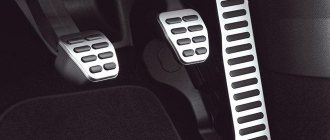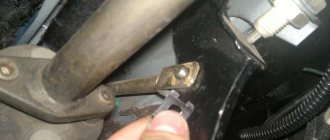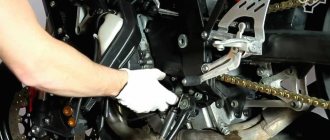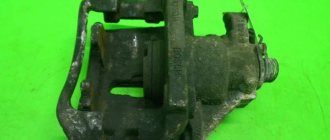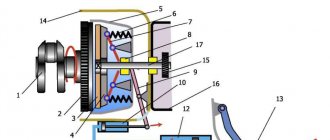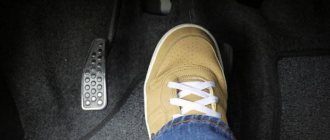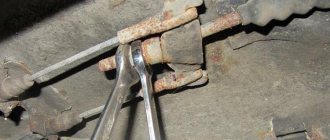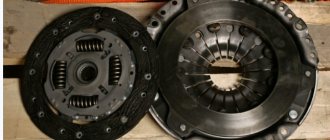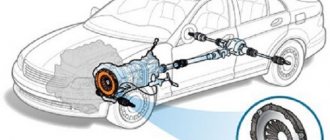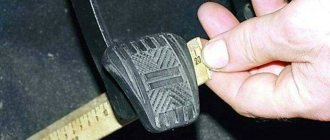In my article today I want to talk about brake pedals, namely, what it should ideally be, tight or, on the contrary, soft, how to find this golden mean?
By and large, the brake pedal can have several positions and states.
The first state is the one provided by the manufacturer, when when you press the brake pedal there are no dips or jerks, and no special effort is required. There are also two other unpleasant pedal conditions that can cause driver anxiety.
This refers to the state of the pedal when it is excessively tight or, on the contrary, very soft. Both one and the second phenomenon are equally unacceptable and indicate malfunctions and the need for urgent repairs of the brake system.
A stiff brake pedal can become stiff for several reasons, and they may not necessarily be associated with the traditional “sores” that are typical for all brake models. However, I still propose to consider the most common of them, and I will also try to give practical advice on how to eliminate them.
Most problems that cause the brake pedal to become soft are related to either the vacuum booster or the brake master cylinder.
Reasons why the brake pedal becomes hard:
1. Clogged air filter of the vacuum booster. Treated by replacing the air filter;
2. Sticking of the valve body in the vacuum booster. The vacuum booster needs to be replaced;
3. The vacuum booster diaphragm is damaged. Solved by replacing the vacuum booster;
4. Faulty vacuum booster tip. The tip should be replaced;
5. Sticking or failure of the check valve in the vacuum booster. To eliminate, it is necessary to replace the check valve;
6. The check valve of the vacuum booster is faulty or the seal is broken, resulting in fuel entering the chamber of the vacuum booster. The vacuum booster with check valve should be replaced;
7. Damage to the hose that connects the vacuum booster and the intake manifold, or the hose fastening on the fitting is loose. It can be treated by replacing the hose, or, if possible, by tightening the fastening clamp. The condition of the hose should be regularly monitored, this is especially true in the cold season. As long as the hose is cold, it retains the necessary rigidity - the brakes function normally. However, after several tens of minutes of motor operation, the hose heats up and becomes more elastic. If, for example, during inspection you do not find delamination, the capacity of the hose will decrease, which in turn can cause problems with the brake pedal.
8. The sealing rings in the working wheel cylinders are swollen; this often occurs as a result of fuel and lubricants getting on their surface, or as a result of using low-quality brake fluid. To correct this situation, it is necessary to repair the working brake cylinders and replace the brake fluid
Here are several ways to independently check the performance of the vacuum booster.
First of all, start the engine to allow a vacuum to occur in the system. After this, press the brake pedal; if the pedal is hard, this is a clear sign of a faulty hose or amplifier. Then turn off the engine and wait 5-7 minutes, do not press the brakes.
It is necessary to specify the malfunction; to do this, press the pedal. If it is still hard, most likely the fault lies in the vacuum booster valve.
There is also another test. When the engine is not running, it is necessary to depress the brake pedal several times in order to remove the vacuum in the brake system. After this, without releasing the pedal, you need to start the engine; if the pedal begins to move down a little, the amplifier is in order.
Cause of soft brakes
A soft brake pedal, as a rule, simultaneously indicates several breakdowns in the brake system. More precisely, there are many reasons why the brake pedal can become soft. Sometimes this phenomenon is also called brake pedal failure.
The most common reasons why brakes may become soft are:
Air brake system. Troubleshooting occurs by bleeding the brakes and removing air from the brake system.
Airing can occur for the following reasons:
1. Low level of brake fluid in the expansion tank, depressurization of the brake system;
The brake pedal has become hard: the reason
So, during operation, you can discover that the brake pedal has become hard, medium or too soft. The reasons for a tight pedal, that is, when the brake pedal on a car is too hard, can be either a design feature of a particular car or a malfunction. In other words, a hard brake pedal may be normal for certain car models. If the brakes become hard for another reason, repairs are necessary.
To transfer pressure, brake fluid is poured into the system. The fluid is supplied through steel pipes and rubber hoses from the master cylinder to the brake wheel cylinders. The working cylinders use their piston to transmit pressure to the brake calipers, pressing the brake pads against the brake disc or drum.
The list of main reasons why the brake pedal is hard to press or the brake pedal is not pressed includes problems with the vacuum booster. The following problems should be noted:
- Malfunction of the vacuum brake booster limit switch. Replacing the end switch solves the problem;
- The vacuum booster also has a special check valve. If the valve sticks or does not work, the specified element must be replaced;
- The VUT may also have a dirty air filter, which prevents dirt from entering the system. If the filter is clogged, in a similar situation the brake pedal is also pressed hard;
- The amplifier also has a special check valve. If the VUT valve is stuck, this element must be replaced;
- Often the reason why the brake pedal becomes hard after several presses or the brake pedal is hard after parking is the brake booster diaphragm. The VUT diaphragm breaks or cracks, and the entire amplifier must be replaced;
- At the same time, we note that fuel may enter the booster chamber (often due to a broken check valve), which will also immediately affect the operation of the brake pedal;
- One common cause of a hard brake pedal that won't press down is the hose connecting the intake manifold to the booster. The specified hose wears out and becomes deformed, that is, over time it may require replacement. It also happens that it loosens on the fitting. In this case, a tight fit can solve the problem;
- The list ends with the use of dirty brake fluid that has lost its properties, the ingress of third-party fluids into the brake cylinders, as well as swelling of the sealing rings. To fix the problem, the cuffs and seals need to be replaced (repair of brake cylinders), and the brake fluid must also be replaced. In some cases, entire brake cylinders need to be replaced.
Checking the brake system
VAZ 2109 bleed the brakes
Before starting this work, it is necessary to check the entire system for its leaks. To do this, place the car in a garage with an inspection hole. Carefully clean the joints of rubber hoses and pipelines from accumulated dirt.
You need to clean it carefully - take a rag with your hands, rotate it up and down, clean one side, then the other. After this, you need to make several presses on the pedal, put a load on it or stop it with something else. Necessary:
- Go down into the pit.
- Inspect the connections and the quality of the hoses themselves.
- The joints must be dry.
- If liquid has leaked, then use gentle movements and a special wrench to tighten the connections.
VAZ 2109 bleeding the brake system
- Securely secure the tubes.
- Visually assess the suitability of the rubber hoses; they should not have ruptures in the upper shell or cracks.
Premature damage to rubber hoses can occur due to:
- drainage of mineral oils and grease onto them;
- as well as mechanical damage.
According to the technical specifications of the manufacturer, the hoses must be changed after 150,000 km or after five years of operation of the vehicle. Upon completion of the inspection of the condition of the system from the inspection hole, under the body of the vase, it is necessary to inspect all joints for tightness. This is also done under the hood, in the engine part. In addition, it is necessary to check the fluid level in the master cylinder reservoir. If necessary, the level must be increased to the maximum level.
If the brake pedal is pressed hard: diagnostics
As you can see, a tight brake pedal is often due to problems with the vacuum booster. At the same time, its operation can be quickly checked on the spot.
To diagnose VUT, you can use two methods. In the first case, you need to start the engine for the vacuum booster to start working. Normally, the pedal is soft; after two or three strong presses on the brake, the engine speed will briefly increase.
Another test involves pressing the brake several times with the engine off. Normally, the pedal should be soft for 2-3 presses, then it becomes hard. After this, you should press the brake and start the engine without releasing the pedal. The pedal should go down after the engine starts. If this does not happen, then you also need to look for a problem with the VUT.
Personal experience of car owners.
Alexei:
“I am a driver with little experience, so it was very difficult for me to independently determine the cause of the pedal hardness. I couldn’t even figure out how to remove this or that part in order to diagnose specific problems. In the end, I took my Audi A6 to a service station. The craftsmen working there determined the nature of the damage without even removing the units. Correct diagnostics helped me significantly save on repairs.”
Ivan:
“When the amplifier of my VAZ 2114 broke down, I verified that it was faulty in a simple way. To do this, the hose is removed and the amplifier is turned off. The presence of a vacuum when starting the engine indicates that the “vacuum valve” is faulty.”
Novel:
“The vacuum booster and cylinders are very difficult to diagnose. The best vehicle diagnostics can be provided only by those car services that have pressure gauges.”
Soft brake pedal: reasons
Having figured out why the brake pedal can be hard, you should pay attention to an equally common problem when the brake pedal has become soft. In such a situation, the brakes may be weak and perform poorly, which is no less dangerous than a hard pedal.
In extreme cases, the brake pedal may not rise after being pressed or may sink to the floor when braking. Naturally, in the case of a “cotton” pedal, owners are interested in what is the cause of the malfunction, why the pedal is soft after bleeding the brakes, and also how to make the brake pedal harder.
If bleeding has already been carried out, there is a high probability that mistakes were made, undetected breakdowns, brake fluid leaks, etc. occurred. For example, drivers often encounter a problem when, after replacing the brake pads, the pedal is soft, the brake pedal falls off after replacing the brake fluid, after bleeding the brake pedal fails, but the fluid does not drain, etc.
- One way or another, the main reason is depressurization of the brake system. Pipes fray and crack, problems with brake cylinders are possible, dirty brake fluid damages the cylinder mirror. Jamming of the TC pistons should not be ruled out.
At the same time, it is necessary to inspect the locations of all connections, fittings and other elements, since even a few drops of brake fluid leakage have no effect on the level in the reservoir, but air still enters the system, which is the cause of the soft pedal.
It should also be taken into account that if certain elements of the brake system have been changed (discs, pads, drums, working cylinders, etc.), in this case the braking efficiency will be slightly reduced until the parts are broken in. In this case, over several tens of km. The pedal may also feel softer than usual, or the brake pedal may alternate between being soft and stiff.
If the brake fluid is dirty, old and has lost its properties, it may boil due to heat. This leads to the brake pedal sinking or becoming too soft (“cotton”). This situation is dangerous because the problem may have a so-called “floating” nature. If such symptoms appear, you need to start with a complete replacement of the brake fluid.
Problems when paying with bank cards
Sometimes difficulties may arise when paying with Visa/MasterCard bank cards. The most common of them:
- There is a restriction on the card for paying for online purchases
- A plastic card is not intended for making payments online.
- The plastic card is not activated for making payments online.
- There are not enough funds on the plastic card.
In order to solve these problems, you need to call or write to the technical support of the bank where you are served. Bank specialists will help you resolve them and make payments.
That's basically it. The entire process of paying for a book in PDF format on car repair on our website takes 1-2 minutes.
Hello everyone, so the other day I began to notice that the brake fluid began to rapidly decrease from the reservoir, and the brakes became less effective, I decided to open the drums and it was clear that one cylinder was completely bad, I decided to change it, I came home from the night, slept and went to work, took off the wheel, I can remove the drums without any problems, this is generally a huge +, less problems))
Next, I decided to start right away by loosening the cylinder mount)
I filled it with water and started tapping the bolts,
I managed to tear them off without any problems, but everything was wrong with the tube, I don’t have a special key, I had to carefully tear it off with a 10-open-end wrench and tap it, and after about 5 minutes of such manipulations, things started to work,
Now since the pads are in the way and I was going to change them anyway, we remove them. The most difficult thing is the top spring, and I managed the rest with wiring, I passed it through the coil and bent it very conveniently)) When I removed all the springs, I removed the cotter pin and washer Well, we remove everything and throw off the cylinder, quite a bit of brake fluid leaks out)
The replacement was simple, I removed it, and the main thing is to do everything carefully. All cylinder installed
Then we put everything back together, I installed new pads, everything is just the main thing, then tighten the upper spring since it is the stiffest, and that’s it) we put on the drum and drive on, the main thing is then to loosen the handbrake, which I haven’t done yet) and bleed the brakes. And now my feil When I did it on the other side, things went faster, but I made a mistake! Having installed everything, I went to get cutting wheels and other small things; at this time the brake fluid on the left rear wheel was leaking and the cylinder was squeezed out, due to my carelessness! I didn’t put the block in the lower groove, and thus it turned out to be fucked up and I drove off like that, I didn’t realize it right away, the brakes disappeared, well, when approaching the house, in the end I had to disassemble everything again and walk to the store for a new cylinder, well there’s a 24-hour Ladovsky store nearby spare parts)) in the end I installed everything, bled the brakes now the fire is just not usual)) My problem so don’t rush) Good luck to everyone on the roads and don’t break down
Why is the brake pedal higher than the gas pedal?
Drivers often wonder why on many models all the pedals in the car are not on the same plane. As a rule, on a car with an automatic transmission, the brake pedal is noticeably higher than the gas pedal. On cars with manual transmission, the clutch and gas are also often lower than the brake.
Let us note that there is a lot of debate on this matter and there are a number of conjectures and assumptions. Some car enthusiasts claim that this is inconvenient, others complain that if the pedals were in the same plane, it would be easier to control the car, etc.
Let’s also add that some owners believe that the brake pedal is placed higher in order to increase its travel, and also taking into account the need for more force (lever).
Finalization
Many, believing that the brakes are bad and repairs do not help them, decide on significant alterations and tuning. For example, tuning the brake system of a VAZ 2110 may include replacing the rear drum mechanisms with disc ones.
It is especially important to know here that braking of the rear wheels should be softer and occur a little later than the front wheels to prevent skidding.
Another possible idea for tuning is replacing the vacuum booster as well. Instead of standard ones, they are installed from Lada Priora. This usually helps, first of all, in that vibration is not felt and the pedal works with optimal force.
And do not forget - after each intervention in the brakes, they need to be pumped.
You can read more about replacing the vacuum brake booster in this material:
The most important organ in any car is the brake system. It must be in perfect condition, because our lives depend on it. One of the main indicators of the efficiency of this unit is the pedal, which must always differ in the state of pressing that is familiar to the foot. This rule cannot be neglected and if the slightest changes occur, adjustments or repairs must be made immediately. Below we will look at what needs to be done when the brake pedal becomes hard, does not press at all, or grabs at the very end of its stroke. We will also pay attention to the issues of self-diagnosis and study all the reasons for the failure of this mechanism.
Let's sum it up
Taking into account the above, it becomes clear that any deviations from the norm in the operation of the brake system (either a soft brake pedal, a hard brake pedal, or a combination of problems) require immediate diagnosis. After identifying the malfunction, it is necessary to properly eliminate the problem.
You also need to promptly change the fluid, bleed the brakes, inspect the brake hoses for defects and leaks, install new brake pads, discs or drums in a timely manner, lubricate the brake caliper guides, etc. This approach will allow you to safely operate the car and achieve high-quality performance of the braking system in any conditions.
The brake pedal falls to the floor, the brakes disappear unexpectedly, after replacing the brake fluid, pads, brake discs: the main causes of the malfunction.
Reasons why the engine may stall when you press the brake. The power unit stalls during sudden braking, when the clutch and brake are depressed, etc.
What is engine braking? How to perform this technique correctly. Pros and cons, sleep recommendations. Engine braking on cars with automatic transmission.
How to brake correctly in a car with a manual transmission: types of standard braking on a manual transmission, emergency and emergency braking, tips.
The clutch pedal has fallen: why does this happen? The main reasons why the clutch pedal fails, what should the driver do if the clutch fails.
Driving a vehicle always involves various risks. A high-quality braking system can avoid most of them. Thus, if you find a hard or soft brake pedal, you need to immediately address this problem. If such problems arise, you should not delay; it is better to conduct a thorough diagnosis to find out what exactly is the cause of the problem.
Device
Hydraulic brakes are installed on the machine and operate generally reliably. They are double-circuit and have a diagonal distribution. That is, if one part suddenly fails, then braking by another circuit is possible. For the sake of safety, the VAZ 2110 brakes operate diagonally, one circuit is the right front and left rear wheels, the other is also diagonal.
This device allows you to brake efficiently (without skidding and other troubles) even in the event of a malfunction, if the brakes in one of the circuits are lost.
Let's consider the design of the brake system. The hydraulic drive includes a vacuum booster, as well as a dual-circuit regulator that creates pressure in the rear brakes.
The brake caliper design is described in this article:
In addition, the hydraulic drive is equipped with pipelines divided into two circuits, hoses and brake mechanisms that provide braking to the front and rear mechanisms.
The hydraulic drive is activated by a pedal located in the cabin (middle). Here are the main components of the hydraulic drive:
- Vacuum booster.
It is designed in such a way that it creates pressure on the master cylinder piston, and thus causes braking; Vacuum brake booster - Pressure regulator drive.
It is through it that the working brake fluid flows to the rear brake mechanisms; Brake pressure regulator drive - The pressure regulator itself.
Already from the name it is clear that this device is responsible for the force of pressure, its decrease or increase. He does this depending on how loaded the rear axle of the car is; Pressure regulator - Main cylinder with pistons, equipped with a reservoir.
The filler neck of the tank is equipped with an emergency fuel level sensor; Master brake cylinder - Brake mechanism for the front wheel.
Its main parts are the disc, pads and wheel cylinders. The mechanism also provides an indicator to prevent complete wear and malfunction of the linings; Front wheel brake - Brake mechanism for the rear wheel. Unlike the front disc brakes, the rear ones are drum brakes. This is the factory configuration. However, many car owners believe that their device does not provide high-quality braking, and change them to disc ones.
The brakes require attention. Without waiting for the warning light to come on, indicating a critical level of fuel fluid or wear of the linings, and even more so, without allowing the brakes to completely disappear, you need to carry out preventive checks.
Particular attention should be paid to all connections and hoses, since the “escaped” brake fluid will not make it possible to brake, and from here it’s not far from tragedy.
Should I be concerned if the brake pedal is stiff or soft after bleeding?
The manufacturer has ensured that the brake pedal is pressed as easily and conveniently as possible. It is important that there is no need to exert significant effort while pressing, and various dips and jerks are unacceptable. Regardless of whether the brake pedal is soft and does not stop well, or there is a problem of some other kind, it is important not to leave things to chance. In general, if the brake pedal fails, then you urgently need to go to a service station or top up the brake fluid yourself. Most likely there is a leak in the brake system.
Both a tight pedal and too easy its movement are an alarming symptom that can indicate a number of serious problems.
Swelling of rings in cylinders.
The condition of the brakes largely depends on what kind of brake fluid is used during operation. If it is a product of a well-established company, the vehicle is rarely damaged or disabled. But if the fluid is of poor quality, one or more cylinders may not function well due to their O-rings swelling. The same thing happens when fuel and lubricant gets on the ring.
Previously, especially in the era of the Soviet automobile industry, the car owner sooner or later had to sort out the working cylinders. Such an activity was long and burdensome even for professionals. But now hardly anyone will do this if the vehicle is faulty. From the point of view of saving time, it is much easier to change them, and at the same time the brake fluid. However, you can avoid unnecessary financial costs if you use high-quality, albeit expensive, liquid from the very beginning, since repair costs are always higher.
The brake pedal fails (the brakes are too soft)
It is worth noting that if you feel weak braking when pressing the brake of a VAZ 2109 or any other model, you need to think about the fact that these may be features of a particular vehicle. Perhaps you just moved from another car, so you feel some discomfort while driving a new car.
On the other hand, such a symptom can also occur when air enters the system. It should be noted that in the event of depressurization of the system, the pipeline may completely burst and completely fail. This can be corrected by bleeding the brakes. At the same time, you should diagnose the cylinders, check the level of the brake fluid, as well as its quality (often air gets into the brake system simply because there is too little fluid) and perform a full check of the vehicle (the latter will help determine the presence of hidden problems) ;
If the pedal becomes soft after replacing the brake fluid, then, as a rule, the problem lies in the use of a low-quality mixture. Alternatively, it is possible that air got into the system during replacement - this is also worth paying attention to.
It is also quite common for the pedal to feel soft after bleeding the brakes. First of all, you should bleed the master cylinder. As a rule, this solves a similar problem. Alternatively, there may be problems with the anti-lock braking system (if equipped). In any case, if the brakes are soft after bleeding, you should approach this task responsibly. Perhaps you should contact specialists who can quickly and effectively fix the problem.
Video about the operating principle of the brake master cylinder:
“In 90% of cases, these features are corrected, and the child can study in a regular school”
The initiator of the Dyslexia Belarus project, Valeria Bobkova, says that in the world, according to the WHO classification, dyslexia is classified as a “learning difficulty.” Children with this feature go to regular schools.
“However, there is a local difficulty here: very often such children are misdiagnosed and labeled as having mental retardation.” Then the child, who is absolutely normal in intellectual terms, is sent to a school for children with delayed development. I believe this is due to low awareness on the topic of dyslexia,” says Valeria Bobkova.
According to her, dyslexia is diagnosed at the age of five to seven years, in the UK - from the age of four.
- This is a feature, not a disease. Now there are many technical means that can maximally compensate for the inconvenience for people with such features: special fonts, screen color and text pages. Experts insist that with early diagnosis and qualified correction, these features can be made practically invisible to a person, notes the initiator of the Dyslexia Belarus project.
The photograph is used as an illustration. Photo: Alexander Chuguev
For dyslexics, there are programs to correct this feature. There are free programs on the websites of the International Dyslexia Association or the British Association.
“According to the European Dyslexia Association, in 90% of cases these features are corrected, and the child can continue studying in a regular secondary school,” continues Valeria Bobkova. — In the USA and Great Britain there are special schools for dyslexics. In addition, instead of a written exam, dyslexics often take an oral one; up to 20% more time can be allocated for written tests. The only centers in our country that can hardly be classified as dyslexia correction centers are centers for correctional and developmental education and rehabilitation. This is a government agency that exists in every district. However, there are currently only a few specialists on this topic, which is why there are problems with the diagnosis and correction of dyslexia in Belarus.
Causes of a hard brake pedal
If the brake pedal is either soft or hard, or the pressure is too tight, there are also several possibilities for the problem. The main reasons here include:
- clogging of the air filter of the vacuum booster. Basically, here you need to replace the filter itself;
- increased sizes of sealing rings in wheel cylinders.
Typically, in this case, the pedal became hard after changing the brake fluid.
You should not use low-quality death; it is better to buy the liquid recommended by the manufacturer. As a result, such a problem will not occur; - presence of mechanical damage on the diaphragm. The element should also be replaced;
- problems with the functioning of the tip in the amplifier. It is necessary to replace it with a working part;
- check valve stuck. These components cannot be repaired, so they should be replaced;
- Vacuum booster valve sticking. You just need to replace this element;
- presence on the hose between the intake manifold and the deformation amplifier or loosening of the fastening. First, try tightening the fastening clamp. If this does not help, you need to change the hose.
We discussed why a soft or hard brake pedal effect occurs. Regardless of the cause of this problem, malfunctions of the braking system are quite serious, so you should take a very responsible approach to diagnosis and repair. If you cannot fix the problem yourself, you should immediately contact a professional - in no case is it recommended to get behind the wheel of a car in which the brakes do not work correctly.
Malfunctions of the "vacuum"
A vacuum brake booster (VUT), or simply a “vacuum booster,” creates in the vehicle’s vehicle the pressure necessary for their proper operation.
If the amplifier is not working well, the pedal simply won't push through. Since the vacuum booster is a rather complex part consisting of many components, a malfunction of any of them can lead to this situation. And since a breakdown of an amplifier component, as a rule, requires its replacement, correct diagnostics will help save the car owner not only time, but also money.
If the filter element of the “vacuum tank” is clogged, it is enough to replace it so that the amplifier begins to function normally again. This also applies to a damaged vacuum booster diaphragm, and problems with the tip or check valve. It is enough to replace one damaged component, and the vehicle will act like new again. It is important to accurately diagnose what exactly needs to be changed.
Sometimes no major replacements are required at all. For example, in a situation where the vehicle is depressurized. The seal can be broken in two cases: either the hose between the “vacuum reservoir” and the intake manifold is damaged, or the clamps are loose. And if in the first case replacing the hose is still necessary, then in the second it is enough to tighten the clamps. This can also be done at a car service center, but the car owner is quite capable of dealing with such a problem on his own.
But it happens that the unsuitability of only one component completely renders the VUT unusable. This most likely occurs in a situation where vehicle malfunctions are ignored for a long time. As a result, a badly damaged valve moves to such a position that it disables the entire “vacuum tank”. An example is damage when a valve jams in the amplifier, and the latter has to be completely replaced. This is one of the most expensive types of vehicle repair.
We recommend: How to replace valve stem seals without removing the cylinder head?
